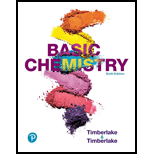
A solution of
Want to see the full answer?
Check out a sample textbook solution
Chapter 14 Solutions
Pearson eText Basic Chemistry -- Instant Access (Pearson+)
- Acetic Acid reacts with sodium hydroxide in the following fashion:CH_3COOH(aq)+NaOH(aq) > H2O(l)+NaC2H3O2(aq) If 3.60mL of vinegar needs 41.0mL of 0.150M NaOH to reach the equivalence point in a titration how many grams of acetic acid are in a 1.50 qt sample of this vinegar? Express your answer using three significant figuresarrow_forwardConsider the equilibration of a weak base B (K, = 7.63 × 10¬³) between water (phase 1) and benzene (phase 2). %3D Which expression represents D, the distribution ratio? B Which expression represents KD, the distribution represents the unprotonated form of the base and BH+ constant? B represents the unprotonated form of the base represents the protonated form of the base. O [B]2 [B]] and BH† represents the protonated form of the base. [B]2 [B]] + [BH*]] [BH*]2 [BH*]2 [BH+]1 [B]] + [BH*]1 [BH*]2 [BH*]] [B]2 [B]] + [BH*]] [BH*]2 [B]2 [B]] + [BH*]] [B]] Calculate D at pH 8.41 if Kp = 49.0. Will D be larger or smaller at pH 6.00 than at pH 8.41? %3D smallerarrow_forwardAcetic acid is a weak acid. Its formula is CH3COOH. Only the last H is an acid proton. Vinegar is usually 5 % (v/v) acetic acid. If 25.00 mL of vinegar is titrated by a standardized 0.9315 M NaOH solution, it takes 22.38 mL to reach the endpoint. Calculate the molarity of acetic acid in the 5 % (v/v) vinegar.arrow_forward
- A solution of 0.152 M NaOH is used to titrate 25.0 mL of a solution of H2SO4H2SO4: H2SO4(aq)+2NaOH(aq)→2H2O(l)+Na2SO4(aq) If 23.0 mL of the NaOH solution is required to reach the endpoint, what is the molarity of the H2SO4 solution? Express your answer with the appropriate units.arrow_forwardPart A A solution of 0.158 M NaOH is used to titrate 23.5 mL of a solution of H,SO4: H2SO4 (aq) + 2N2OH(aq) → 2H2O(1) + NazSO. (aq) If 39.4 mL of the NaOH solution is required to reach the endpoint, what is the molarity of the H2SO4 solution? Express your answer with the appropriate units. HA ? molarity = Value Units Submit Request Answer Previous al Draft Speec...pdf MacBook Airarrow_forwardA certain indicator, HA, has a ?a value of 7.9×10^−7. The protonated form of the indicator is yellow and the ionized form is red. What is the p?a of the indicator? p?a= A generic salt, AB2, has a molar mass of 287g/mol and a solubility of 2.80 g/L at 25 °C. AB2(s)↽−−⇀A2+(aq)+2B−(aq) What is the ?sp of this salt at 25 °C? ?sp=arrow_forward
- A 10.00 mL sample of 1.20 M HNO2 (analyte) (pK, = 3.34 and K = 4.57x104) is titrated with 1.20 M NaOH (titrant), what is the pH when 5.00 mL of NaOH are added to the analyte? Question 4 A 10.00 mL sample of 1.20 M HNO2 (analyte) (pK, = 3.34 and K, -4.57x104) is titrated with 1.20 M NaOH (titrant), what is the pH when 10.00 mL of NaOH are added to the analyte? Assume Ku = 1.0 x 10-14 Using the titration curve below for the titration of 10.00 mL of the analyte NH3 with HCl(aq) (titrant) to estimate pKa for NH3 Titration of 10.00 mL Ammonia (ag) with Hydrochloric Acid (ag) 12.0 11.0 10.0 9.0 8.0 7.0 5.0 4.0 3.0 2.0 1.0 0.0 0.0 2.0 4.0 10.0 12.0 140 16.0 180 20.0 6.0 Volume of HCI Added (mL) 8.0arrow_forwardWhat are the concentrations of H+ and OH− in asolution of 0.02 M NaOH?arrow_forwardIf we spill a Strong Base in the laboratory, there is a squeeze bottle ofWeak acid available to completely neutralize the spill. a) What volume (in liters) of 0.40 M CH 3 COOH is required to completelyneutralize 20.0 mLs of 0.80 M KOH? Do not round off your answer. b) What is the pH at the Equivalence Point? ka CH 3 COOH =1.8 x 10 -5arrow_forward
- 7. How many mL of a 0.20 M NaOH solution are needed to neutralize 10 mL of 0.30 M H2SO4 solution. 2NAOH + H2SO4 → Na2SO4 +2H2O (1) M(base)V(bases)= (2) M(acid)V(acid)arrow_forwardYou are titrating a 1.033 g sample of white vinegar solution (5.0% acetic acid) with a 1.00 M NaOH titrant. At the endpoint of titration, 0.89 mL of NaOH was used. What is the mass % of acetic acid based on your experimental results? CH3COOH = 60.052 g/molarrow_forwardQ7. Karl Fisher titration is used to determine moisture content of food products according to the chemical reaction below: 2H₂O + SO₂ + 12 → H₂SO4 + 2HI (i) Name the reaction that involved. (ii) Identify the FOUR major chemical components needed in the Karl Fisher reagents. (iii) Rewrite the actual chemical reaction(s) that involved during Karl Fisher titration. (iv) Outline the function of each major chemicals in the reaction stated in answer (iii).arrow_forward
 Chemistry & Chemical ReactivityChemistryISBN:9781337399074Author:John C. Kotz, Paul M. Treichel, John Townsend, David TreichelPublisher:Cengage Learning
Chemistry & Chemical ReactivityChemistryISBN:9781337399074Author:John C. Kotz, Paul M. Treichel, John Townsend, David TreichelPublisher:Cengage Learning Chemistry & Chemical ReactivityChemistryISBN:9781133949640Author:John C. Kotz, Paul M. Treichel, John Townsend, David TreichelPublisher:Cengage Learning
Chemistry & Chemical ReactivityChemistryISBN:9781133949640Author:John C. Kotz, Paul M. Treichel, John Townsend, David TreichelPublisher:Cengage Learning Chemistry: The Molecular ScienceChemistryISBN:9781285199047Author:John W. Moore, Conrad L. StanitskiPublisher:Cengage Learning
Chemistry: The Molecular ScienceChemistryISBN:9781285199047Author:John W. Moore, Conrad L. StanitskiPublisher:Cengage Learning Chemistry: Principles and PracticeChemistryISBN:9780534420123Author:Daniel L. Reger, Scott R. Goode, David W. Ball, Edward MercerPublisher:Cengage Learning
Chemistry: Principles and PracticeChemistryISBN:9780534420123Author:Daniel L. Reger, Scott R. Goode, David W. Ball, Edward MercerPublisher:Cengage Learning Chemistry: Principles and ReactionsChemistryISBN:9781305079373Author:William L. Masterton, Cecile N. HurleyPublisher:Cengage Learning
Chemistry: Principles and ReactionsChemistryISBN:9781305079373Author:William L. Masterton, Cecile N. HurleyPublisher:Cengage Learning




